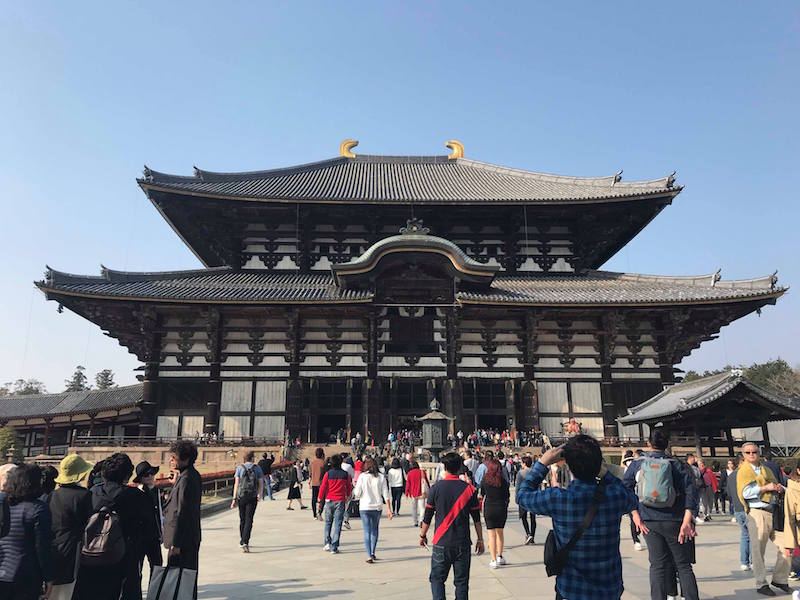Nara, the capital city of Japan’s Nara Prefecture, is one of Japan’s most popular tourist destinations. In March 2018, when I was in Japan for a second time (I was attending a conference), I had an opportunity to visit this ancient capital. On 25 March, three of my friends came to Kobe from Tokyo to take me to Kyoto and Nara for sightseeing. Much to my delight, they were well informed about the sights and became my guides.
We first visited the holy site of Kofuku-ji, a Buddhist temple and one of the eight historic monuments of ancient Nara on the UNESCO World Heritage List. To enter the main shrine hall, one has to pay the entrance fee. From a distance, we had a look the shrine and observed a long queue of devoted Buddhists who had waited to buy tickets to go in for a short prayer.
Kofuku-ji was first built in 669 by Kagami-no-Okimi, the wife of Fujiwara no Kamatari, a Japanese statesman from the formidable noble house of Fujiwara. The building was first completed at Yamashina in Yamashiro Province (present-day Kyoto) but was then moved to Fujiwara-kyo, the imperial capital of Japan, before moving to its current location in 710. The temple was damaged and destroyed numerous times by civil wars and fires and subsequently rebuilt. But many important halls, such as the nandaimon, chumon and corridor buildings were never reconstructed or renovated until today. In the temple grounds, the main attraction is Goju-no-to, a five-storied pagoda at a total height of 50.1 meters and known to be the second tallest wooden pagoda in Japan. Today, the temple is known as one of the two head temples of the Hasso school of Buddhism. The Hasso school represents the Yogacara Buddhist philosophical tradition that was brought to Japan from India via China.
While going to Todai-ji, we were amazed by our visit to the nearby deer park. When I saw the deer, I immediately remembered the deer park at Sarnath in Varanasi, India, where the Buddha first taught his Dhamma and established the monastic community. Just as that sacred locale is special for Indians, the deer park in Nara is sacred site for the Japanese. Though the park is called Nara Park, many also call it “deer park” because of its main attraction, thousands of freely roaming deer. According to Japanese folklore, these deer are considered sacred as they came from Takemikazuchi-no-mikoto, one of the four gods of Kasuga Shrine, a celebrated Shinto shrine in Nara. We joined the many visitors in taking photos and feeding the deer crackers. These crackers are snacks edible to the deer and which are sold to tourists and pilgrims for them to feed to the quiet and friendly animals.
It was not long after that Todai-ji came into sight. The temple was first constructed in 752 as the head temple of the provincial Buddhist temples in Japan at the time. It is known to be the world’s largest wooden building. After entering the main hall, we prostrated before the Buddha Vairocana. Vairocana is a celestial Tathagatha, a sambhogakaya Buddha, the embodiment of the Buddhist concept of emptiness. In Japanese, this particular statue is called Daibutsu, or “giant Buddha,” and it is one of the world’s largest bronze statues of the Buddha in a sitting position. Crowds of people sifted into the shrine hall where several smaller Buddha statues and models of the former and current buildings are on display. Another popular attraction in the hall is a pillar with a hole at its base through which people can pass from one side to another with a wish of achieving enlightenment in the future.
 The complex of Todai-ji is spacious. It covers a number of smaller temples, halls and sites that includes Todai-ji Museum, Nagatsudo Hall, Hokkedo Hall, Kaidanin Temple, and Shosoin Storehouse. There is also a museum, library, research centre, and auditorium. In 1998, the temple was listed in the UNESCO World Heritage Site. It currently serves as the headquarters of the Kegon school of Japanese Buddhism.
The complex of Todai-ji is spacious. It covers a number of smaller temples, halls and sites that includes Todai-ji Museum, Nagatsudo Hall, Hokkedo Hall, Kaidanin Temple, and Shosoin Storehouse. There is also a museum, library, research centre, and auditorium. In 1998, the temple was listed in the UNESCO World Heritage Site. It currently serves as the headquarters of the Kegon school of Japanese Buddhism.
As it was late afternoon, I and my friends unfortunately missed out on visiting the Shinto shrine and Fujiwara family seat, Kasuga-taisha, and the Nara National Museum located in Nara Park, which displays Japanese Buddhist art. This was my first temple visit in Japan and I was so impressed. I felt at peace during the visit and will never forget my moments there.


No Xintoísmo ocorre também a incorporação dos deuses? Como é chamado o médium? A.K. Sim. Os médiuns são chamados de yorimashi e são, na maioria das vezes, mulheres e crianças. Também são médiuns as miko, hoje mais conhecidas como assistentes dos templos shinto. professional writing
Such a amazing post dear beautiful temple dear.
What an awesome post. Thanks for sharing
Amazing Post, Thank you for sharing this post really this is awesome and very useful